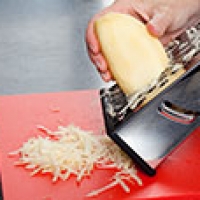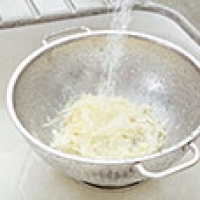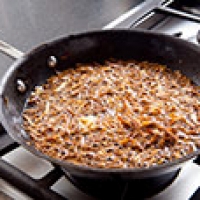HORSERADISH-CRUSTED BEEF TENDERLOIN
From choclytcandy 15 years agoIngredients
- 1 beef tenderloin center-cut Châteaubriand (about 2 pounds), trimmed of fat and silver skin shopping list
- kosher salt (see note) shopping list
- 3 tablespoons panko bread crumbs shopping list
- 1 cup plus 2 teaspoons vegetable oil shopping list
- 1 1/4 teaspoons ground black pepper shopping list
- 1 small shallot , minced (about 1 1/2 tablespoons) shopping list
- 2 medium cloves garlic , minced or pressed through garlic press (about 2 teaspoons) shopping list
- 1/4 cup well-drained prepared horseradish (see note) shopping list
- 2 tablespoons minced fresh parsley leaves shopping list
- 1/2 teaspoon minced fresh thyme leaves shopping list
- 1 small russet potato (about 6 ounces), peeled and grated on large holes of box grater shopping list
- 1 1/2 teaspoons mayonnaise shopping list
- 1 1/2 teaspoons Dijon mustard shopping list
- 1/2 teaspoon powdered gelatin (see note) shopping list
How to make it
- Note: if using table salt, reduce the amount in step 1 to 1 1/2 teaspoons. Add the gelatin to the horseradish paste at the last moment, or the mixture will become unspreadable. If desired, serve the roast with Horseradish Cream Sauce (recipe follows; you will need 2 jars of prepared horseradish for both the roast and sauce). If you choose to salt the tenderloin in advance, remove it from the refrigerator 1 hour before cooking. To make this recipe 1 day in advance, prepare it through step 3, but in step 2 do not toss the bread crumbs with the other ingredients until you are ready to sear the meat.
- 1. Sprinkle roast with 1 tablespoon salt, cover with plastic wrap, and let stand at room temperature 1 hour or refrigerate for up to 24 hours. Adjust oven rack to middle position and heat oven to 400 degrees.
- 2. Toss bread crumbs with 2 teaspoons oil, 1/4 teaspoon salt, and 1/4 teaspoon pepper in 10-inch nonstick skillet. Cook over medium heat, stirring frequently, until deep golden brown, 3 to 5 minutes. Transfer to rimmed baking sheet and cool to room temperature (wipe out skillet). Once cool, toss bread crumbs with shallot, garlic, 2 tablespoons horseradish, parsley, and thyme.
- 3. Rinse grated potato under cold water, then squeeze dry in kitchen towel. Transfer potatoes and remaining cup oil to 10-inch nonstick skillet. Cook over high heat, stirring frequently, until potatoes are golden brown and crisp, 6 to 8 minutes. Using slotted spoon, transfer potatoes to paper towel-lined plate and season lightly with salt; let cool for 5 minutes. Reserve 1 tablespoon oil from skillet and discard remainder. Once potatoes are cool, transfer to quart-sized zipper-lock bag and crush until coarsely ground. Transfer potatoes to baking sheet with bread-crumb mixture and toss to combine.
- 4. Pat exterior of tenderloin dry with paper towels and sprinkle evenly with remaining teaspoon pepper. Heat reserved tablespoon oil in 12-inch nonstick skillet over medium-high heat until just smoking. Sear tenderloin until well browned on all sides, 5 to 7 minutes. Transfer to wire rack set in rimmed baking sheet and let rest 10 minutes.
- 4. Pat exterior of tenderloin dry with paper towels and sprinkle evenly with remaining teaspoon pepper. Heat reserved tablespoon oil in 12-inch nonstick skillet over medium-high heat until just smoking. Sear tenderloin until well browned on all sides, 5 to 7 minutes. Transfer to wire rack set in rimmed baking sheet and let rest 10 minutes.
- 5. Combine remaining 2 tablespoons horseradish, mayonnaise, and mustard in small bowl. Just before coating tenderloin, add gelatin and stir to combine. Spread horseradish paste on top and sides of meat, leaving bottom and ends bare. Roll coated sides of tenderloin in bread-crumb mixture, pressing gently so crumbs adhere in even layer that just covers horseradish paste; pat off any excess.
- 6. Return tenderloin to wire rack. Roast until instant-read thermometer inserted into center of roast registers 120 to 125 degrees for medium-rare, 25 to 30 minutes.
- 7. Transfer roast to carving board and let rest 20 minutes. Carefully cut meat crosswise into 1/2-inch-thick slices and serve.
- STEP-BY-STEP
- Science Experiment A simple egg wash is the usual choice for binding a bread-crumb coating to meat, but it didn't work for our slippery horseradish-bread-crumb mixture. Could we do better by replacing the egg white with gelatin?
- THE EXPERIMENT
- We prepared two pastes, one made with egg white, horseradish, mayonnaise, and mustard and a second where we substituted 1/2 teaspoon of gelatin for the egg white. We applied each paste to a beef tenderloin and then cooked the roasts according to our recipe.
- THE RESULTS
- The gelatin paste kept the bread crumbs attached to meat much better than the egg version. It also had a slight elasticity and allowed it to remain firmly stuck to the meat as we sliced.
- THE EXPLANATION
- Meat and gelatin have a natural affinity. Both are made up of linear proteins that are able to form tight bonds with each other. The proteins in egg whites, on the other hand, are globular (wound up like balls of yarn). Although egg whites do eventually stretch into more linear shapes when heated, they still form a weaker bond with meat than gelatin.
- Note: Crisper Tenderloin Coating Fried potato shreds made for a far crisper—and more flavorful—crust than the typical bread-crumb coating.
- 1. GRATE potato on large holes of box grater for thin slivers that will crisp up quickly.
- 2. RINSE shreds to remove surface starch, then squeeze dry in kitchen towel.
- 3. FRY potatoes in oil to create savory crumbles that keep their crunch.
People Who Like This Dish 3
- anitapicosita Nowhere, Us
- boosan21 Pleasant Valley, CT
- lizzconn Naas Co Kildare, IE
- choclytcandy Dallas, Dallas
- Show up here?Review or Bookmark it! ✔
The Groups
- Not added to any groups yet!




Reviews & Comments 0
-
All Comments
-
Your Comments